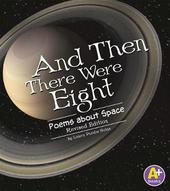
|
And Then There Were Eight: Poems About Space (Poetry)
Paperback / softback
Main Details
| Title |
And Then There Were Eight: Poems About Space (Poetry)
|
| Authors and Contributors |
By (author) Laura Purdie Salas
|
| Physical Properties |
| Format:Paperback / softback | | Pages:32 |
|
| ISBN/Barcode |
9781515761532
|
| Classifications | Dewey:811.6 |
|---|
| Audience | |
|---|
| Edition |
Revised ed.
|
|
Publishing Details |
| Publisher |
Capstone Press
|
| Imprint |
Capstone Press
|
| Publication Date |
1 November 2016 |
| Publication Country |
United States
|
Description
A collection of original, outer space-themed poetry for children accompanied by striking photos. The book demonstrates a variety of common poetic forms and defines poetic devices.
Author Biography
Laura Purdie Salas is the author of more than 100 books for kids and teens. Her work has received the Minnesota Book Award and other honors, including Bank Street Best Books of the Year, and NCTE Notables. She and her husband live in Minnesota and have two monsters of their own, Maddie and Annabelle. When Laura's not reading or writing, she likes to dance, play games, and work with the Minnesota Brass drum corps (which involves a lot of Counting, following Patterns, and creating Shapes on the field). She tries to eat More vegetables and Less brownies, but that is hard! Learn more about Laura at laursalas.com.
Reviews...fresh and lively. Salas is devoted to her craft, and presents poems in different forms, and then explains each in the backmatter. This book would work well for a unit on poetry as it does for a unit on space.-- "Growing with Science blog" A friendly entry, or a return visit, to poetry - an oft-dreaded subject for many ages. Salas has the knack of weaving wonderful words about the adventure that is space and our planets into engaging poems in various formats. This is a terrific piece to complement an integrated curriculum as the poetry easily lends itself to further exploration of the subjects. For example: Why was Pluto no longer considered a planet? Is it now? What do you think? The possibilities are endless. As a work of poetry this can stand alone. Following the poems are definitions of types of poetry (Haiku, Acrostics, etc.) and provide the page number for examples. When was the last time you read a cinquain? The photographs, which are mostly from NASA, are stunning as well, and will lead to further investigation. Take a look at the Sky Eye on page 7. Have fun imagining who or what could belong to that 'eye.' Art students will enjoy this as well, for its visual beauty and placement of text. Salas has done her homework for this book in the "A+ Books" series by making poetry enjoyable visually, textually and factually. Don't forget to read the fine print on most of the double page spreads.-- "Children's Literature Comprehensive Database" Large, clear photos of space accompany verse that describes celestial bodies, space travel, the Mars rover, and more, in simple, concise language. Concludes with two glossaries - one for space terms and one for poetry - and a bibliography. Salas' Seed Sower, Hat Thrower: Poems About Weather (2008) is an excellent companion title.-- "Book Links, Exploring Science and Poetry: " Salas offers a limerick, a cinquain, an acrostic, and 12 other short rhymed or free verse poems on themes astronomical. Accompanied by full-page or -spread photos reproduced with varying clarity, the poems treat such topics as Jupiter's Great Red Spot, a space shuttle takeoff, the Mars Rover, and the Pleiades. Taking a descriptive rather than a ruminative approach, the poet keeps her language simple enough for fledgling readers to tackle: Saturn's/giant/Saturn's/gas/No solid/ground for/trees or grass/Saturn's/banded/Saturn/swings/A skirt of/circling/rocky rings. Closing with twin glossaries of space words and of poetic forms, plus a perfunctory, two-item Read More list, this versatile book will be useful for both science and language-arts units.-- "School Library Journal" This collection of 15 playful poems about outer space presents perennially favorite topics, such as Saturn's rings, Jupiter's rep spot, and shuttle liftoffs, in catchy language paired with inspiring photographs and fun facts. The poems come in a variety of formats useful for many teaching applications. A science unit on planets or space exploration could use this collection to illustrate main points and generate discussion, while a poetry unit would benefit from the inclusion of scientific subject matter to help catch the attention of reluctant readers and writers. The book includes recommendations for further learning and two pages of discussion about the art of poetry with reference to specific poems in different styles. The poems themselves are creative, catchy, and well suited for independent readers or for reading aloud. An unexpected variety of topics and a well-balanced focus on science and language arts are unique strengths, although the book's title may be misleading: only a handful of the solar system's eight planets are represented. Overall, it is a fresh and fun approach to science and language. Glossary. Recommended.-- "Library Media Connection"
|